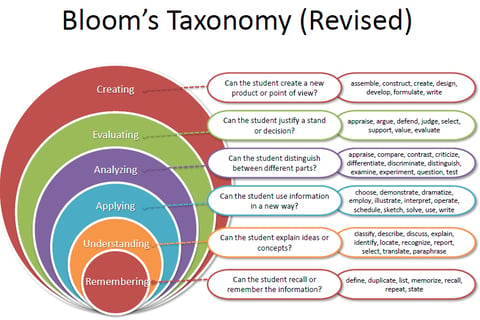What Does a Rigorous Course Look Like? (Part 3)
It doesn’t take extensive training to incorporate rigor in your homeschool, but it does require some fundamental understanding about lower-order and higher-order levels of thinking. In this article I’ll explain how a decades-old education tool can help you evaluate your student’s coursework.
7/8/20245 min read


Defining rigor as moving a student to a place of challenge and hard work where they may make mistakes begs the question: how do I find the place of challenge for my student? One way is to understand the steps learners move through when they encounter new information. This helps you evaluate where your student is in the learning process and what the next step in difficulty should be.
The systematized way educators have learned to organize levels of thinking dates back to the 1950’s. Educational psychologist Benjamin Bloom and his team developed a taxonomy to explain the progression in thinking as people gain mastery over new subjects. Bloom’s early work has been revised over the years, but the basic scaffolding remains essentially the same: ground students in introductory, lower-order thinking (knowledge, comprehension, application) and then move them towards higher-order thinking (analysis, synthesis, evaluation).
Recent revisions have made Bloom’s model even more accessible by incorporating new words/verbs to identify the steps along with a new image that depicts the way each of the levels nests in and relies on the next (see fig. 1). This revamped image more clearly depicts how students must first do the work of learning and comprehending information before they are asked to apply or create something with it.
Fig.1
Source: Stein, Elizabeth. “The Intersection of UDL and Bloom’s Taxonomy.” Middle Web, 17 Mar. 2015, https://www.middleweb.com/21295/the-intersection-of-udl-and-blooms-taxonomy/. Accessed 26 Mar 2024.
Evaluating Your Current Homeschool Curricula for Rigor
The challenge for the homeschool teacher is to make sure the work they require doesn’t stop after comprehension or simple application. You can evaluate the challenge level or your homeschool courses by looking for higher-order thinking activities or projects that include analyzing, evaluating, and creating.
The questions and action verbs on this even more detailed image of Bloom’s Taxonomy can help you be certain your students are working at each of the levels as they learn new material. Locate and examine the textbook/workbook assignments and other activities that require your student to do something with the content knowledge they gain. Check the verbs used. Do they only ask students to identify, explain, or write? If they stop short of asking students to analyze, evaluate, and create, you can level-up the activities using the questions and verbs on the chart. By moving your student to the next level of learning, you increase the difficulty of the course without changing the course material.
IMPORTANT NOTE: Searching for action verbs is an easy way to begin checking an activity’s thinking level; however, you must realize that many of the same verbs can actually be used to design activities at many different thinking levels. For example, the verb explain can be used to ask students to:
Remember – Explain what happened after Goldilocks entered the kitchen.
Understand - Explain why Goldilocks fell asleep in Baby Bear’s bed.
Apply - Explain how you felt when you were caught in the act of doing something you shouldn’t have.
Analyze - Explain whether Goldilocks or the bears should be more frightened in this story.
Evaluate - Explain whether it was right or wrong for Goldilocks to enter the bears’ cabin.
Create - Explain the kind of situation in which it may be morally permissible to enter someone’s home without their permission.
Here’s a tricky example. For an English course, you may ask a student to identify a real-life example of a certain character type you are studying and explain how they are similar to the character in the text. At first glance those verbs identify and explain make this question seem like a knowledge or comprehension question, but because you are asking students to think outside of the text they are studying and to apply the characteristics to people in the real world, you have actually moved them one step to the next level of thinking.
To be sure you are analyzing the activity’s thinking level accurately, look carefully at what the activity is asking students to do using the key questions next to each Bloom’s image. By using both the questions and the action verbs on the Bloom’s Taxonomy chart, you should be able to determine the thinking level of an activity correctly.
Evaluating Published Curriculum
In published curriculum, suggested activities and questions are typically grouped together at the end of a chapter or lesson section of a textbook. In a good published curriculum these will likely be arranged in Bloom’s-levels order. Many companies also offer supplemental materials like workbooks and journals. Most likely they will have plenty of remembering, understanding, and applying questions, so you may only need to check that their resources cover the higher-order thinking levels–analyzing, evaluating, creating. These are most often included at the end of a chapter.
Typically you will find fewer high-level questions or activities because each one will take more time and mental effort. One of the biggest mistakes homeschooling teachers make when using published curriculum is to ignore the higher-level thinking activities because they take more time and effort. Students don’t need to answer every question or to complete every suggested activity in a resource. Be very selective in choosing which activities you assign, but be sure to include items from each of the Bloom’s categories.
Evaluating Curriculum You Design
If you have created your own curriculum, analyze your work carefully to determine which thinking levels you’ve covered and which you have not. Look at all of the related assignments and activities across an entire unit, rather than in individual lessons. Your goal is to cover all of the levels across a unit or chunk of content, not in each daily lesson.
Make sure you have included an interesting mix of lower-order thinking activities. These activities are very important building blocks and should always be included, but variety is critical for engaging student interest. If the remembering and understanding activities always require students to define terms and recall information by answering simple questions, they will quickly get bored.
Next, focus on the kinds of verbs you use at the applying level. Make sure you aren’t constantly asking students simply to solve or write. Check the chart for more interesting ways students can apply the knowledge and understanding they gain.
Then, move to the three higher-order skill levels. You want your students to do something at each of these levels. However, because activities that use higher-order thinking require more from them, you may want to assign just one activity that asks them to do two or more of these at the same time in a given unit. It’s possible to devise projects, essays, or presentations that incorporate all three.
For example, you may ask a student to write an analytical essay comparing how two different authors deal with a common theme and to include an evaluation of which author does so more effectively. This kind of assignment requires students to synthesize information and understanding they acquired from lower-level activities with their own original ideas and judgments to create an original product with a thesis and support.
As you evaluate your homeschool curriculum in each subject area, including electives, make notes about any gaps you detect. Jot down any new ideas that emerge as you work through your curricula.
In Part 4 we’ll discuss how to fill those gaps to provide the challenge and rigor your student needs.
References for further learning:
For a short helpful introduction to the revised Bloom’s taxonomy, including digital-age additions, watch this short video produced by Common Sense Education.
Looking for ways to boost your students’ academic skills during the summer months? Visit my From the Teacher’s Desk page at ElevateAcademicSolutions.com where you’ll find a series of articles written to help students struggling to catch up from Covid-related learning loss.




